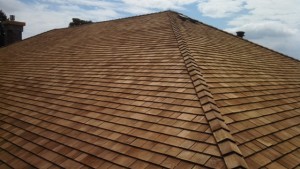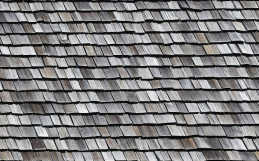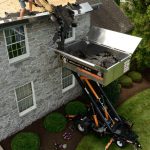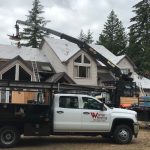From Craftsman to Custom, Tudor to Traditional, and Mid-Century Modern to Victorian, there are a wide variety of architectures to choose from. The style of your home often dictates other aspects of its appearance, from doors, windows, shudders, and even the landscaping and ground.
But nothing is as important as the roofing system, both for how it looks and how it protects the biggest investment many of us will ever make. Believe it or not, the type of roof design architecture can actually play a part in the roofing system itself.
Types of Roof Design Architecture
The following are different types of roof design architecture in their basic forms. As the size of the home increases, you may see a combination of roof types to maximize space or make for a more manageable project. And custom homes may feature three or four different types of roofing styles.
Gabled Roof
This is a relatively straightforward roof design with two sloped sides of the roof meeting at the peak or ridge of the home. Think of the gingerbread houses you used to make during the holidays, or maybe you still do! The slope of the roof may be very steep or it could be slight, but either way, it’s a gable roof.
Bullnose Roof
Also known as a clipped gable roof, take the basic design of a gable roof and then remove the corners from either side. This type of roof design architecture creates a triangle at either end of the ridge, otherwise known as a “hip.” It’s a way to give your roofline an added point of interest.
Crossed Gable Roof
A crossed gable roof is a type of roof design architecture that involves two gabled roofs that intersect each other perpendicular to each other. Picture a long gabled roof running East to West. Now add another gabled roof running North to South, usually in the middle of the “other” roof, but not always.
Another example of a crossed gable roof is having a prominent gabled roof flanked on either side, or just one side, by a roof of a different slope. There is still just one ridge where the combination of roof slopes still meets. This type of roof creates a dramatic entrance.
 Hip Roof
Hip Roof
Where a gabled roof has two sides that meet at the ridge, a hip roof has four sides. All four sides can meet at the top like a pyramid or two opposing sides (West/East facing side for example) meet to create a small ridge that the other sides (North/South in this example) meet at either end of. This allows for eaves around all four sides of the house.
Dutch Gable Roof
This type of roof design architecture is a combination of a gabled roof and a hip roof. Starting from the bottom with a hip roof, the four sides go up to a certain point where it transitions to a gable roof. Now there are two sides that have vertical sides on the front and back of the home.
The other two sides continue on to the ridge. These back and front gables allow for additional attic space if needed, or for adding a window for more natural light or additional interest. This type of roof is popular in farm-style homes because it allows for wrap-around porches.
Gambrel Roof
If you’ve ever seen a big red barn, you’re probably familiar with the gambrel roof. The two sides of the roof meet to create a ridge like a gabled roof, with one twist: Near the top of the roof, the slope changes to a much more gentle degree. Think of a 15-degree slope at the top that then dives down to 60 degrees or more. The double slopes allow for additional storage space at the top of the building.
Mansard Roof
Like the gambrel roof tweaking the gable type of roof design architecture, the mansard roof does the same with a hip roof. The four sides at the top of the roof slope at one degree before transitioning to a much steeper slope. The purpose of this roof is to provide more usable space in the attic, just like the gambrel style. It’s also a very interesting look to give a home.
Bonnet Roof
The principles of the bonnet roof match the mansard type of roof design architecture, but the slopes are reversed. The slopes at the top part of the roof are steep while the slopes at the bottom are much more gradual. This style provides for more porch or patio cover.
Shed Roof
As simple as it can be, a shed roof has just one plane, starting low at one point and higher at the opposite side. These are usually seen on smaller projects (such as a shed obviously) because on a larger building you’ll need more materials to build up the “high” point of the roof to create enough of a pitched roof for water runoff.
Flat Roof
As the name implies, there is little slope at all in a flat roof. There will always be at least a few degrees of slope to allow water to flow off the roof. Where the other architectural styles employ gutters at the end edges of the roof, flat roofs are equipped with scuppers, little openings at the edge of the flat roof that connect to downspouts.
Roofing Materials
No matter what type of roof design architecture your home features, pay close attention to the types of materials you want to use on your roof replacements. Are you replacing the roof on a simple gable-roofed rental or building a custom “forever” home? Although cost is always a pertinent concern, it shouldn’t be the only factor.
Composite or architectural shingles make more sense than slate for the rental while a metal roof will look right at home on a farmhouse with a gambrel roofing style. The roof plays a big part in the overall aesthetics of your home, so the material and even the color of the roofing should be considered.
The installation of the roof is equally important: No matter how good it looks, if a roof leaks, misery is sure to follow. If your roofing features a combination of designs, experience will matter when it comes time to create seamless–and water-tight–transitions.
Warner Roofing & Construction: Experienced Contractors
With a background in construction, Warner Roofing is familiar with all types of architectural home designs and understands the design elements that could affect certain types of roofing. When you work with us, you’ll be working with a design-build company that helps plan the perfect roofing system for your home.
In addition to finding the perfect roofing materials, and providing unsurpassed craftsmanship, Warner Roofing can further protect your home with gutter system installations, repairs, and overlays. Want to add additional points of interest as well as natural light? We have been installing skylights and solar tubes for decades.
Ready to give your roof an upgrade? Get in touch with Warner Roofing.







